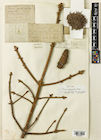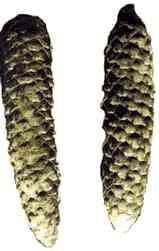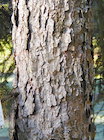 (the species)
(the species)
 (var. notabilis)
(var. notabilis)
 (var. ponderosa)
(var. ponderosa)
Picea asperata
Masters 1906
Common names
Dragon spruce (Farjon 1990); 云杉 yun shan [Chinese] (Wu and Raven 1999), a reference to the exceptionally sharp, stiff needles.
Taxonomic notes
Picea asperata belongs to Clade III R of Ran et al. (2006), which contains P. abies and most of the northeast Asian spruces, including P. crassifolia, P. koraiensis, P. koyamae, P. meyeri, P. obovata and P. retroflexa. These species are conveniently united by a simple, obvious character: all have quadrangular needles, while other Asian spruces have laterally or dorsiventrally flattened needles. Type, E.H. Wilson 3025, collected in the forests near Song Pan, Sichuan.
There are three varieties:
- P. asperata Mast. var. asperata,
- P. asperata Mast. var. notabilis Rehd. & E.H. Wilson ex Sargent 1914 (syn. P. notabilis (Rehd. & E.H. Wilson) Lacass. 1932), and
- P. asperata Mast. var. ponderosa Rehd. & E.H. Wilson ex Sargent 1914 (syn. P. ponderosa (Rehd. & E.H. Wilson) Lacass. 1932).
Note that P. aurantiaca is also sometimes treated as a variety. Farjon (2010) recognizes and describes these varieties, but cautions that this is a variable species and there are as yet few collections of any but the type variety; possibly the situation is comparable to that of Picea abies where morphological variation is related to varied factors, including introgression.
Description
Trees to 45 m tall and 150 cm dbh, typically with a single straight, round trunk and a narrowly conical crown. Bark gray-brown, furrowed into irregular, rough, scaly plates. Young twigs slender, firm, prominently ridged and grooved, glabrous to variably pubescent, shiny brownish yellow or reddish brown, turning gray with age. Vegetative buds ovoid-conical, acute, 6-12 × 5-8 mm, resinous. Leaves directed forward or ascending on upper side of branchlets, parted and spreading laterally on lower side, glaucous or not, straight or curved, quadrangular in cross section, 10-20×1-2 mm, with 3-4 stomatal lines along each surface, apex acute. Pollen cones axillary near ends of shoots, 10-15 mm long, reddish turning yellow. Seed cones terminal, first erect but later becoming pendulous, green, maturing pale brown or reddish brown, cylindric, 5-16×2.5-4.5 cm. Seed scales obovate, 12-20 × 8-16 mm at mid-cone, upper margin obtuse, rounded to emarginate, usually slightly incurved. Bracts rudimentary, 2-3 mm long, included. Seeds obovoid, 2-4 × 1.5-2.8 mm, brown, with an 11 mm wing. Pollination April-May, seed maturity September-October (Wu and Raven 1999, Farjon 2010).
Farjon (2010) distinguishes the varieties as follows:
- Var. asperata has glabrous to pubescent new shoots with mostly appressed bud scales, and 6-12 cm long seed cones; seed scales obovate-oblong, with an obtuse, rounded or truncate upper margin.
- Var. notabilis has glabrous, bright orange-brown new shoots with loosely imbricate bud scales that have a reflexed tip; seed scales are rhombic-oblong and emarginate.
- Var. ponderosa is named for its seed cones, which are 12-15 cm long and rigid, with coriaceous seed scales having an elongated, curved, usually emarginate apex.
Distribution and Ecology
China: E Qinghai, Gansu, Sichuan, Ningxia (Helan Shan), and SW Shaanxi. The type variety is found throughout this range, while var. notabilis and var. ponderosa are confined to western Sichuan; var. ponderosa, in particular, is known only from the type locality on Balang Shan (巴郎山). Occurs in high mountains, at 1500-3800 m elevation, typically on podzol soils in a subalpine continental climate with annual precipitation less than 500 mm (Farjon 2010). Occurs in pure stands, mostly on northern aspects; sometimes in mixed stands with other Picea species, Abies chensiensis, A. fargesii, and Pinus tabuliformis. In Gansu it occurs with Abies nephrolepis, and its most common hardwood associate is Betula albo-sinensis. Near the western limits of its range it overlaps the similar P. crassifolia, while in the east and northeast its ecological analogs are, respectively, P. meyeri and P. koraiensis (Farjon 2010, (Debreczy and Rácz 2011).
The species is assessed as "vulnerable" due to declining population status. Although logging has officially been banned since 1998 in the conifer forests of western China, the ban seems to have not been fully effective, and decline is continuing (Carter and Farjon 2013a). Var. notabilis is assessed as endangered, also due to logging and declining population status, but in this case occurring within a much more restricted area (Carter and Farjon 2013b). Var. ponderosa is assessed as critically endangered for the same reasons, but in this case within an extremely restricted area (Carter and Farjon 2013c).
Hardy to Zone 6 (cold hardiness limit between -23.2°C and -17.8°C) (Bannister and Neuner 2001).
Remarkable Specimens
Ethnobotany
Historically, and to a lesser extent still, this has been an important timber species within its range, the wood mainly used for pulp and for construction. Intact stands have been reduced to less accessible mountain areas, while plantation forestry has begun to replace natural stands as a source of spruce timber, but the plantations are not yet equal to the demand. The species and its varieties are reasonably common ornamentals in suitable (cold, dry) areas in Europe and the USA, with most of these speciments derived from seed collections by E.H. Wilson, Joseph Rock and some other early 20th century plant hunters who travelled widely in southern Gansu and western Sichuan (Carter and Farjon 2013).
Observations
Remarks
The epithet is from the Latin asperatis, rough. Unfortunately Masters (1906) gives no clue what this is referring to.
Citations
Carter, G. and A. Farjon. 2013a. Picea asperata. The IUCN Red List of Threatened Species 2013: e.T42320A2972242. http://dx.doi.org/10.2305/IUCN.UK.2013-1.RLTS.T42320A2972242.en.
Carter, G. and A. Farjon. 2013b. Picea asperata var. notabilis. The IUCN Red List of Threatened Species 2013: e.T191625A1991287. https://dx.doi.org/10.2305/IUCN.UK.2013-1.RLTS.T191625A1991287.en.
Carter, G. and A. Farjon. 2013c. Picea asperata var. ponderosa. The IUCN Red List of Threatened Species 2013: e.T191626A1991294. https://dx.doi.org/10.2305/IUCN.UK.2013-1.RLTS.T191626A1991294.en.
Farjon, Aljos. 1990. Pinaceae: drawings and descriptions of the genera Abies, Cedrus, Pseudolarix, Keteleeria, Nothotsuga, Tsuga, Cathaya, Pseudotsuga, Larix and Picea. Königstein: Koeltz Scientific Books.
Masters, M.T. 1906. On the conifers of China. Journal of the Linnaean Society, Botany 37:419. Available online at www.botanicus.org.
See also
The species account at Threatened Conifers of the World.
Farjon (2010).







